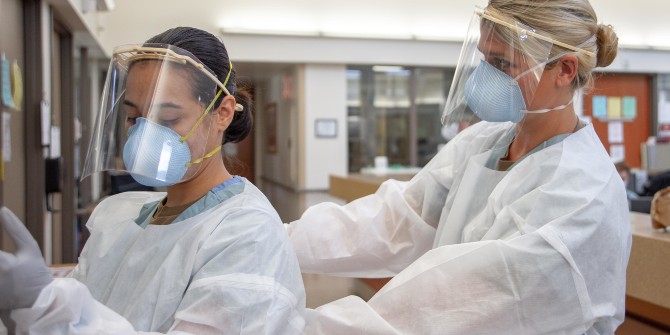Closing borders and quarantining arrivals stops new COVID cases from coming into a country, but is economically and personally costly. Enzo Weber (University of Regensburg), Till Strohsal (Freie Universität Berlin), Zhen Zhu (Wrightway Aviation Technologies) and Duaa Serhan (State University of New York at Binghamton) suggest alternative border control strategies.
When COVID-19 hit, many countries sealed their borders to foreign visitors. As the latest wave of infections recedes in Europe, these countries face the question of how and when to reopen. Although it may increase the risk of importing new cases, which can then spread domestically – possibly leading to new lockdowns – returning to a sense of normalcy is critical for the wellbeing of both people and the economy.
Over the past year, a number of governments have gone through repeated cycles of relaxing borders and then locking them down again in response to new waves of infection. If the economy is going to fully recover, however, sustainable border control options are desirable. What border control options can bring the world back together again without the fear of another lockdown?
To answer this question, we developed a customised variant of the workhorse model of epidemiology. We found that structured border control strategies which accord with domestic control policies are the key to sustainability. With sufficient domestic control and with the help of vaccine rollouts, in most cases completely closed borders are not necessary and milder measures are sufficient.

The current containment strategies differ widely across countries. Countries can be classified into three major groups based on their goals and approach:
- those able to eliminate domestic cases and resume normal life (i.e., current domestic reproduction number R ≈ 0 due to no domestic cases, but with a potential R >> 1 when there are new cases);
- those aiming to keep COVID under check while effective vaccines are being deployed (i.e., R < 1 for an extended period of time, until herd immunity happens because of a vaccine);
- and those aiming for herd immunity either strategically or involuntarily (i.e., R > 1 for an extended period time until herd immunity is achieved, with or without vaccination).
The first group is a small subset of countries in the world that have eliminated the virus domestically and where domestic life has returned to normal (e.g., China, New Zealand). For these, reopening borders requires mandatory quarantine. Without it, even stringent checks at the border combined with effective contact tracing cannot prevent another outbreak, as it would only take a few infected travellers to slip through to seed COVID back into the country. In fact, China has implemented an extremely strict border entrance policy, including a 14-day institutional mandatory quarantine in addition to multiple obligatory tests. Nevertheless, local lockdowns have still been needed from time to time to deal with local outbreaks. These harsh measures have largely worked in countries like China, but what about countries that are not pursuing a ‘Zero COVID’ strategy?
The second group tries to contain the spread of the virus, without eliminating it. Those regions can open up to each other and those of the first group without many additional border control policies, so long as the number of imported cases does not increase. Once these countries start opening up borders, it is key to closely monitor imported cases. While it would be possible to test all travellers on arrival, this might be too restrictive and costly. An alternative would be to make use of random sampling or data from individual tests to find out the proportion of travel-related positive cases. When the rate of imported cases from any given country exceeds a given threshold, which can be determined by our modelling framework, border controls should be tightened for that country.
But for those countries with a persistent lockdown strategy, even opening borders to the third group of countries, which lack sufficient internal controls, is not completely out of the question. What should the restrictions be? Naturally, mandatory institutional quarantine upon arrival would be highly effective. However, these extremely restrictive measures can be avoided when using a combination of pre-departure screening and test-and-isolate after arrival. According to our results, this would be enough to keep the virus dynamics under control.
Existing border policies in many parts of the world are largely in line with these recommendations. For example, current regulations in Germany and other EU states group foreign countries into low-risk, high-risk and unspecified (a middle group). For low-risk countries, unrestricted entry is allowed. For high-risk countries, travel is only permitted in exceptional cases and travellers must go through both a pre-departure test and mandatory quarantine that can be shortened by a negative test. For countries on neither list, people from the Schengen area are allowed to travel without restrictions. People from other countries can only do so if they have an “urgent need for travel”. Our results imply that – once the third wave is under control – equal treatment of countries in and outside the Schengen area would be possible. This point will become very important over the next few months. At the moment, the lists of high-risk areas are still very long, but as vaccinations progress, more and more countries will fall out of this group. Of course, critical virus variants may require special treatment.
The pandemic has repeatedly shown that it does not forgive political mistakes and laxity. This is precisely why it is important to determine which level of openness is sustainable and which is not. Depending on a country’s internal containment strategy, closed or virtually closed borders are often not necessary to avoid further lockdowns. However, there are clear preconditions for how travel must be organised and controlled. Naturally, balancing different containment measures including border control and various domestic restrictions is a national political decision, but forward-looking border control policies can bring the world together as much as the realities of the pandemic allow.
This post represents the views of the authors and not those of the COVID-19 blog, nor LSE.





